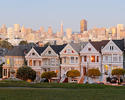One of the arguments against single-family zoning is that separating housing from other uses forces people to drive to shops, work, and other destinations. read more »
Portland
West Coast Blues
Few regions have been more consistently Democratic than the West Coast. Even compared with the Northeast, where Republicans occasionally win governors’ offices, the appropriately named “left coast” has been adamantine in its progressivism. Republicans haven’t won statewide office in California in years; in Oregon, it’s decades. Washington has elected a Republican secretary of state, but she now serves in the Biden administration. And the region’s major cities are overwhelmingly blue. read more »
- Login to post comments
Portland Downtown Devastated by COVID
The number of people working in downtown Portland dropped from more than 103,000 in mid-2019 to 13,000 in mid-2020, according to a State of the Economy report recently published by the Portland Business Alliance. The report doesn’t actually show numbers, but the chart below, which I took from the report, can be used to make pretty close estimates. read more »
- Login to post comments
The Battle for Cities
America’s cities face an existential crisis that threatens their future status as centers of culture, politics, and the economy. Many urban advocates continue to delude themselves that U.S. cities are about to experience a massive post-pandemic return to “normal.” But the disruptive technological, demographic, and social changes of recent times are more likely to upend the old geographic hierarchy than to revive it. read more »
- Login to post comments
High-Speed Rail: An Evaluation
Note: This article is adapted from the recently published Reason Foundation report Assessing the Results of the High-Speed Intercity Passenger Rail Program, by Wendell Cox read more »
Studying the Wrong Cities Will Lead to Repeating Their Mistakes
The junket factor must be the only logical criteria by which various industry “study tours” overseas are planned. How else to explain how entirely inappropriate the choices are? The list of cities identified for “study” by Australian development and planning industry bodies reads like the pages of a glossy weekend travel magazine: we’ve seen study tours to New York, Los Angeles, San Francisco, Copenhagen, London, Vancouver and (of course) Portland. The purpose? One recent blurb promises it is “to expand our horizons and bring new ideas back to Aussie shores.” read more »
- Login to post comments
Of Niche Markets and Broad Markets: Commuting in the US
The six transit legacy cities - mostly urban cores that grew largely before the advent of the automobile - increased their concentration of transit work trips to 57.9% of the national transit commuting, according to the 2018 American Community Survey. At the same time, working at home strengthened its position as the nation’s third leading mode of work access, with transit falling to fourth. The transit commuting market share dropped from 5.0% in 2017 to 4.9% in 2018. read more »
- Login to post comments
How to Sell Forced Densification to Libertarians
When cities pass zoning rules (as Missoula, Portland, and many Portland suburbs have done) mandating minimum-density zoning — so that people are forced to either build high-density housing in existing low-density neighborhoods or build nothing at all — libertarians lead the charge against such rules. But urban planners have managed to achieve the same result, and gain the support of some who consider themselves libertarian, by: read more »
- Login to post comments
Inclusionary Zoning Flops in Portland
As the price of housing continues to rise in many cities, one popular progressive policy idea to address it is inclusionary zoning. Inclusionary zoning requires that a certain percentage of units in a building be priced at below market, targeted at people who earn some fraction of the area median income. Often this set aside is required in exchange for density bonuses or other things the developer might want. read more »
- Login to post comments
Portland’s Congestion Plans Are Working
Portland’s transportation policies are working. At least, they’re working if you think their goal is to increase congestion in order to encourage people to find alternatives to driving. At least, the increased-congestion part is working, but not many are finding alternatives to driving. read more »
- Login to post comments






















